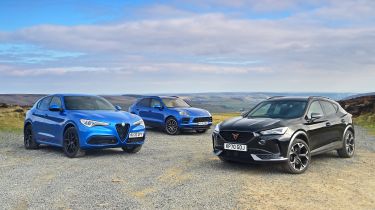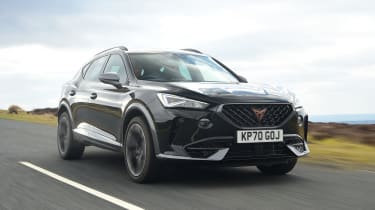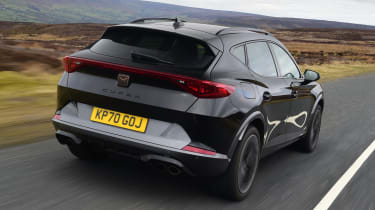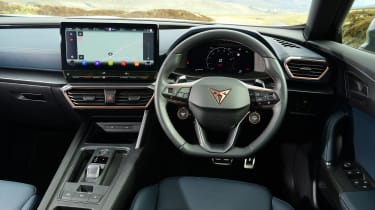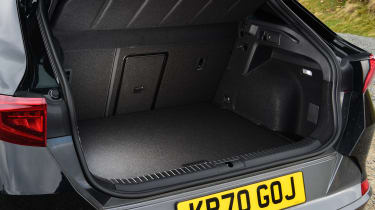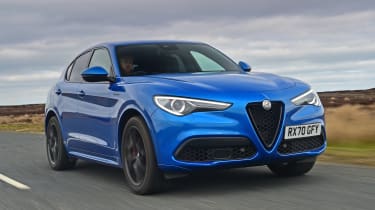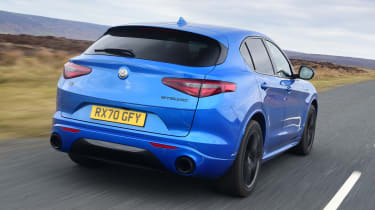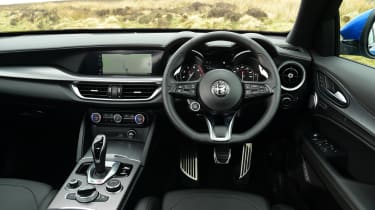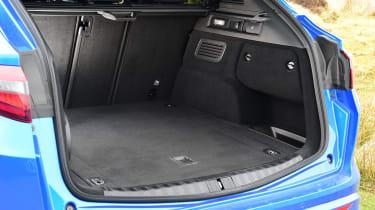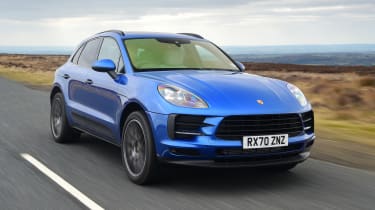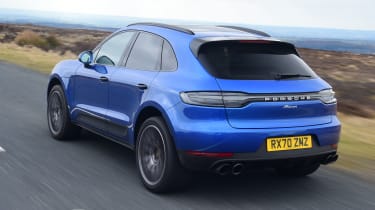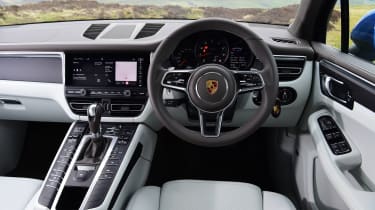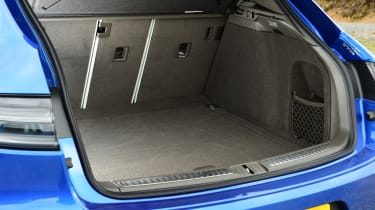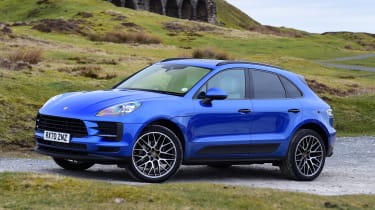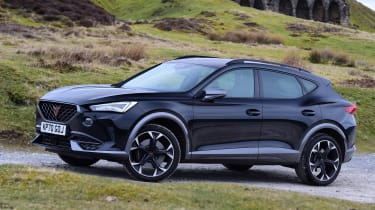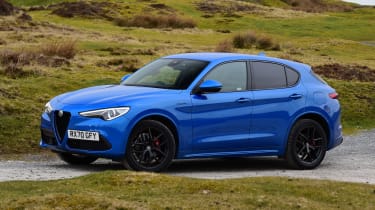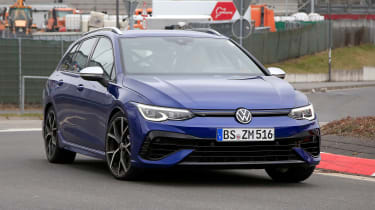Cupra Formentor vs Alfa Romeo Stelvio vs Porsche Macan
Can the new Cupra Formentor stack up to the Alfa Romeo Stelvio and Porsche Macan in this sporty SUV battle?
Launching an all-new performance SUV is hard enough given the level of competition in the class, but launching one in tandem with a completely new brand? That takes some courage and a lot of confidence, but that’s exactly what Cupra is doing with the Formentor.
This performance SUV is the first bespoke model from Cupra, formerly the performance arm of SEAT. Being part of the Volkswagen Group means all the mechanicals are familiar, especially the 306bhp 2.0-litre turbocharged engine sitting beneath the skin of our flagship model. But the Formentor’s design inside and out is something quite different to what we’ve seen before.
Yet the Cupra isn’t in with an easy ride; at this price point, between £500 and £600 per month on a PCP deal, it faces impressive opposition, such as the Alfa Romeo Stelvio and Porsche Macan. In Veloce spec, the Alfa packs 276bhp, a brilliant chassis and head-turning looks.
But the Cupra’s biggest challenge comes from Porsche; the Macan might be getting on a bit, but this premium SUV still sets the benchmark when it comes to ride, handling and performance.
Cupra Formentor
| Model: | Cupra Formentor VZ2 310 4Drive |
| Price: | £39,830 |
| Engine: | 2.0-litre 4cyl turbo, 306bhp |
| 0-62mph: | 4.9 seconds |
| Test economy: | 27.0mpg/5.9mpl |
| CO2: | 193g/km |
| Annual road tax: | £1,305 |
The Cupra is the smallest, lightest and cheapest car in this test, and also packs the most punch, with 306bhp. It comes as standard with a seven-speed dual-clutch automatic gearbox and four-wheel drive. Our VZ2 edition starts from £39,830. Let’s see how it fares against some established rivals.
Used - available now

2018 Porsche
Macan
39,427 milesAutomaticPetrol3.6L
Cash £38,282
2018 Porsche
Macan
99,212 milesAutomaticDiesel3.0L
Cash £18,995
2021 Porsche
Macan
18,300 milesAutomaticPetrol2.9L
Cash £56,499
2018 Porsche
Macan
60,900 milesAutomaticDiesel3.0L
Cash £22,222Design & engineering
You’ll have previously seen the Cupra badge on the back of fast SEATs, but now it stands on its own feet, spun off as its own separate company and with its own bespoke cars. This Formentor crossover is the very first dedicated Cupra model; you won’t find any SEAT badges here.
Like a lot of VW Group models, the Formentor sits on the familiar MQB set of chassis components that also underpins other crossovers such as the SEAT Ateca and VW Tiguan. It’s available with a variety of engine options. The line-up kicks off with two four-cylinder turbos: a 148bhp 1.5-litre and a 187bhp 2.0-litre. Above those sit two plug-in hybrids: a 201bhp and more powerful 242bhp version of the VW Group’s familiar 1.4-litre powertrain.
At the top of the line-up, and the version we’re testing here, is the 310 4Drive model, powered by a 306bhp 2.0-litre turbo. It drives through a seven-speed DSG gearbox and four-wheel-drive system, enabling a 0-62mph time of 4.9 seconds – the quickest here – and top speed of 155mph.
It’s only available in the Cupra’s upper tier of trim levels: VZ2 and VZ3. Kit is very generous, and a 12-inch infotainment system with wireless Apple CarPlay, three-zone air-conditioning, LED headlamps, a wireless charging pad and a 10.25-inch digital instrument cluster are the standout features. Our VZ2 edition gets unique 19-inch alloys, dynamic chassis control and leather interior included, too.
As well as the quickest car of the trio, it’s also the smallest, measuring only 4,450mm long; that’s 246mm shorter than the Porsche and 237mm less than the Alfa. It’s also well over 100mm lower to the ground than both of its competitors here, too.
Driving
Climb into the Cupra and you could mistake it for a hatchback behind the wheel. The seating position is low, as is the base of the windscreen, so you feel like you sit much closer to the road and in a more performance-focused vehicle than you do in the Stelvio.
That’s backed up by the engine, too; the Formentor is the most powerful and quickest of this trio, with 306bhp and a 0-62mph time of 4.9 seconds. The 2.0-litre engine is a familiar unit, found in the likes of the Golf GTI and Audi S3, but it remains a really effective motor. There’s a hint of turbo lag as you squeeze the throttle, but by 2,500rpm the engine spins freely and pulls with force right up to 6,000rpm.
You can dial the Formentor through Normal, Sport and Cupra driving modes, each bringing a greater degree of aggression and engine noise that gets pumped through the car’s speakers. Yet an Individual mode allows you to tailor the engine, steering and noise set-ups to suit your liking.
Cupra’s 4Drive all-wheel-drive system comes as standard and makes the Formentor a rapid point-to-point car. The clutch-based system shuffles the power to where it’s most needed most and deploys it effectively, allowing you to make quick and seamless progress. It makes the Formentor more surefooted and secure than adjustable.
The brilliant body control also contributes here; the Cupra just doesn’t lean or roll through corners. Unlike the Alfa, it remains flat and composed, and coupled with security of the 4WD system, makes this the quickest of the three cars to cover ground in. It’s just a shame that the steering, whichever setting you have it in, is pretty numb and devoid of feel.
Knock it back to Comfort mode, and when you’re not making use of its full 306bhp, the Cupra rides pretty well, too. It doesn’t have the underlying suppleness of the Macan, but it’s comfortable enough to qualify as an everyday family car.
Practicality
Despite the Formentor being the shortest and lowest of the three cars here, there’s more passenger space inside than what its rivals offer. That sloping rear roofline hasn’t had an impact on headroom – adults over six foot can still sit comfortably. You could even sit three abreast thanks to the shallow transmission tunnel.
Kneeroom is also the most generous here, and that’s despite the wheelbase of the Formentor being more than 200mm shorter than both of its rivals’.
Where it does lose out is boot space; the 420-litre load bay isn’t much more than you’d get in a regular hatchback. The Cupra is also the only car here to come as standard with a space-saver spare wheel.
Ownership
Not enough Cupra owners took part in our Driver Power 2020 survey for the brand to rank. But because all Cupras will be sold through SEAT dealers for the foreseeable future, and mechanical parts are shared, SEAT’s 14th place finish is a good indicator of how Cupra will perform.
The Formentor scored the full five stars in its Euro NCAP crash test, thanks in part to standard safety kit such as lane-keep assist, forward collision warning, predictive cruise control and driver alert system.
Running costs
The Cupra is the cheapest of the three cars to buy outright here, costing from just under £40,000. That means for the Formentor will cost a standard-rate taxpayer £2,847 per year to run as a company car. Over three years it’s expected to retain a decent 54.4 per cent of its value, meaning it will be worth £21,668 after that period.
On test we averaged 27mpg, which is a little down on what Cupra claims is possible, but not so bad given the level of performance. Based on our figure, you can expect to pay around £2,500 on fuel over 12,000 miles.
Testers’ notes
“There’s no doubt about the ability of the Formentor; it’s a cracking performance crossover. But there is a lot of work to be done on making the Cupra brand visible and appealing to potential customers.”
Alfa Romeo Stelvio
| Model: | Alfa Romeo Stelvio Veloce |
| Price: | £49,495 |
| Engine: | 2.0-litre 4cyl turbo, 276bhp |
| 0-62mph: | 5.7 seconds |
| Test economy: | 24.4mpg/5.4mpl |
| CO2: | 211g/km |
| Annual road tax: | £1,305 |
At £49,495, the Alfa Romeo Stelvio Veloce is the most expensive car here, but also the largest. Like its rivals, it uses a 2.0-litre four-cylinder turbo engine and develops 276bhp and 400Nm of torque. But does it do enough to compete?
Design & engineering
The Stelvio was instrumental in the rebirth of Alfa Romeo because it was the first SUV the company had produced in its history, and was one of the first genuinely competitive cars to emerge from the Italian brand for years.
It shares its platform and running gear with the Alfa Romeo Giulia saloon, but its chunkier SUV proportions are far more in line with customers’ needs and tastes today.
It’s the tallest and widest car here, but thanks to its aluminium underpinnings the Stelvio is only 16kg heavier than the much smaller Cupra Formentor, at 1,660kg. By comparison, the Porsche weighs an additional 210kg over the Alfa.
Like its two rivals, the Stelvio can be had with a variety of engines, but the Veloce edition we have here makes use of a 276bhp 2.0-litre four-cylinder motor that’s paired with an eight-speed automatic gearbox and four-wheel-drive system. It sits in between its rivals when it comes to power and performance, with Alfa claiming a 0-62mph time of 5.7 seconds. The Cupra and Porsche manage the same sprint in 4.9 and 6.7 seconds respectively.
It’s the most expensive car here, but only a match for its rivals on kit; standard equipment includes wireless phone charging, bi-xenon headlamps, adaptive cruise control, heated leather sports seats and an 8.8-inch infotainment system with Apple CarPlay and Android Auto connectivity. Adaptive dampers and an automatic tailgate are both extras.
Like the Porsche, the Alfa is a bit on the old side, but its cabin is still a nice place to sit. Build quality isn’t a match for its two rivals’, though, with some of the materials, especially the darker plastics, feeling a little cheap. At this price point it really should be better and its shortcomings are highlighted by the quality of the Porsche, which is cheaper.
Driving
The first thing that strikes you when you climb in the Alfa is the driving position. You sit a lot higher in the Stelvio than in the Porsche or Cupra, which gives you a great view of the road ahead. But as these are billed as performance SUVs, it would be better to have a slightly lower, more cocooning driving position.
The Stelvio sits between the Macan and Formentor when it comes to performance; its 276bhp 2.0-litre turbo propels the SUV from 0-62mph in 5.7 seconds. The engine spins quite keenly once past 2,500rpm.
Although the most expensive car here, the Alfa doesn’t get adaptive dampers (a £1,100 option) or a dual-clutch gearbox. Both of these have an impact on how the Stelvio rides and handles; the Alfa’s body control isn’t as tight as its rivals’ here, leaning more in corners, which means it doesn’t respond as well to quick changes in direction.
It’s a shame because the steering is really direct and has plenty of natural feel, unlike the Cupra’s. We think being able to tighten up the body control with Alfa’s SDC Suspension would make a difference here.
The eight-speed automatic gearbox works well enough, but in this company its shortcomings are highlighted. It’s just not as snappy as the two dual-clutch units in the Cupra and Porsche; ask for multiple downshifts in quick succession and there’s a notable delay between you pulling the chunky aluminum paddle and the gearbox responding.
Day-to-day the auto slurs its gears nicely, keeping the process smooth, but the Stelvio’s ride quality could be better. It fidgets about over small road imperfections a lot more than its rivals here.
Practicality
In this company the Stelvio is the largest car, but those proportions don’t mean it’s the most spacious one. The Alfa loses out to the Cupra when it comes to the room inside; there’s space for three adults in the back, but kneeroom isn’t as generous as that in the Formentor.
The Alfa hits back with a bigger boot. The 525-litre load bay is almost 100 litres larger than what you get in the Cupra, and dropping the rear bench increases the space to 1,600 litres. Again, that’s the biggest of the three, but an electric tailgate is an optional extra.
Like its rivals, the Alfa also gets a full suite of parking sensors as standard, plus a reversing camera to help make manoeuvering that little bit easier.
Ownership
Alfa was the only one of the three brands in this test to rank in our Driver Power 2020 satisfaction survey, and on the whole the brand scored well given its former poor reputation for reliability. The brand finished ninth out of 30 in our survey, while the Alfa’s dealer franchises finished 14th out of 25.
As standard the Stelvio gets lane-departure warning, forward collision warning and autonomous emergency brake. However, blind-spot monitoring tech comes as part of a pack that also includes driver attention alert, traffic-sign recognition and traffic-jam assist.
Running costs
The Alfa is the most expensive car to buy outright and also on a PCP, because of its low residual values. Our experts predict the Stelvio will retain 41.1 per cent of its value over a three-year period. That’s some way off the Cupra’s 54.4 per cent and Porsche’s 62.2 per cent figures. It means if you buy the Stelvio for £49,495, after three years it will only be worth £20,342.
On our test the Stelvio was also the least fuel- efficient, managing a figure of 24.4mpg. The Alfa will cost you around £2,800 in fuel alone if you cover 12,000 miles a year.
Testers’ notes
“A big pull for potential Stelvio buyers is the way it looks. It’s by far one of the most handsome SUVs on the market and Alfa offers it in a beautiful metallic green, for £700, that really makes it stand out.”
Porsche Macan
| Model: | Porsche Macan |
| Price: | £48,965 |
| Engine: | 2.0-litre 4cyl turbo, 242bhp |
| 0-62mph: | 6.7 seconds |
| Test economy: | 29.1mpg/6.4mpl |
| CO2: | 232g/km |
| Annual road tax: | £1,850 |
The Macan is the most popular model Porsche sells, and with good reason. However, the entry-level model we have here is down on power over the Cupra and more expensive, starting from £48,965. Does it do enough to justify its price?
Design & engineering
If you’re in the market for a fast, relatively compact and premium SUV, the Porsche Macan has long been the go-to option. It’s been on sale for almost seven years, but subtle improvements over time have ensured that it’s remained at the top of its class.
To ensure parity with the Cupra, the Macan we have here is the entry-level option. It’s simply called the Porsche Macan, and uses a version of the same 2.0-litre four-cylinder turbo that you’ll find under the Cupra’s bonnet. As standard it comes paired with a seven-speed PDK gearbox and four-wheel drive.
However, the 2.0-litre unit in the Macan is less powerful than that in the Cupra, developing 242bhp and 370Nm of torque; that’s a deficit of 64bhp and 30Nm. Combined with the extra weight of the Macan, 230kg in total, the Porsche is a little off the pace when it comes to performance; the 0-62mph sprint takes 6.7 seconds against the Cupra’s 4.9.
Although the Macan is due to be replaced with an all-new model within 12 months, the cabin and overall quality are still mighty impressive for a seven-year-old SUV. The fit and finish, plus the quality of materials, are all first rate; you can certainly see where your extra cash has been spent in the Porsche.
The centre console is a little button-heavy, but a slick 10.9-inch infotainment system sits within the dash rather than perched on top of it, like in the Cupra. It’s a touchscreen only, but is easy to use and has lots of detail to all of the menus and sub-menus.
Even as an entry model it’s very well equipped, coming as standard with 18-inch alloys, eight-way adjustment on the front seats, three-zone air-con, automatic LED headlights, heated front seats, cruise control, automatic tailgate and a 10-speaker stereo.
Driving
The step up in quality and build when you climb into the Macan is immediate. These cars all cost between £500 and £600 per month on a PCP deal, but the Porsche feels like it’s in a different league inside.
That, to a point, also extends to the way it goes down the road. This entry-level Macan effectively uses the same 2.0-litre four-cylinder motor found in the Formentor, but is down on power and gives away 64bhp and 30Nm of torque to the Cupra.
That performance deficit is stark on the road; you wouldn’t call the Macan slow, but the engine lacks the urgency you get from the Cupra – evident in its 0-62mph time of 6.7 seconds, which is almost a full two seconds slower than the Spanish model.
Where the Macan counters is with its superb chassis balance, steering feel and sense of agility. It may lack the grunt you’d expect from a Porsche, but it certainly feels like one through the corners. The steering has a real heft to it and a connection to the front wheels that is totally absent in the Cupra, which gives the German model a lovely sense of fluidity as you sweep from corner to corner. Body control is pretty faultless, staying taut and upright even during fast changes in direction.
Unlike the Alfa, there are three levels of control for the dampers – Normal, Sport and Sport Plus – which give a greater degree of adjustability to how the Macan goes down the road. You can isolate the dampers from the car’s main setting, allowing you to have the Porsche in its most aggressive driving setting but the damping in Normal, which takes the edge off the ride over rougher ground and gives a nice sense of fluidity.
Day to day, the Macan has a lovely relaxed demeanor; the large and optional 21-inch wheels don’t do the low-speed ride any favours, but the quality of the damping makes it a very pleasant car to trundle round in.
Practicality
The Macan is the longest car here, yet it has the least amount of passenger space. Knee and headroom are generous enough, but you’d struggle to fit three adults in the back comfortably. The Cupra is the best of these three in this regard.
Yet the 488-litre boot is a decent size and comes with a powered tailgate as standard; dropping the rear bench frees up a total of 1,503 litres of space. If you don’t opt for the £245 spare wheel there is also an underfloor storage area to keep valuables out of sight.
Ownership
Porsche didn’t rank in our Driver Power 2020 survey, but the brand has a solid reputation for building reliable and proven performance cars. The Macan is the most popular model the German car maker sells.
It scored the full five stars in its Euro NCAP crash test and comes as standard with cruise control, lane- departure warning and hill-hold assist. There’s a full suite of parking sensors and a reversing camera, too.
Running costs
Few new cars on the market hold their value like Porsches; over three years the Macan is expected to retain a whopping 62.2 per cent of its original price. That means the German SUV will still be worth more than £30,000 after that period, whereas the Alfa Romeo will be worth £20,000 in comparison.
To run as a company car the lower-rate taxpayer will pay £3,482 in Benefit-in-Kind per year, that’s around £600 more than the Cupra. That figure rises to £6,964 a year for the higher-rate earner.
On our test the Macan returned the best fuel economy of the three cars, averaging 29.1mpg. That figure actually exceeded what Porsche says the Macan is capable of returning.
Testers’ notes
“The new Macan that arrives in 12 months time will be fully electric. So not to alienate some customers, Porsche will sell this current car alongside the new electric version until demand takes a notable dip.”
Verdict
First place: Porsche Macan
It may be the oldest car here, but the Macan remains the go-to option for buyers after a quick and luxurious performance SUV. The way the Porsche drives belies its size, with superb body control and an excellent chassis. This entry-level car may lack some grunt, but the rest of the package more than makes up for it; stepping up to the V6-powered Macan S is also a bit of a bargain, costing only an extra £34 a month on a PCP deal.
Second place: Cupra Formentor
As a debut model, Cupra has knocked it out of the park with the Formentor. Coming second to the Macan, and only just, is no shame at all. The Formentor rides and handles incredibly well for an SUV, delivers blistering performance and, despite its relatively compact proportions, it’s the most practical car here. The level of standard kit is very generous and it’s the cheapest of the trio to run and buy. Hats off to Cupra.
Third place: Alfa Romeo
Few SUVs look as striking as the Stelvio, but good looks only get you so far. The Alfa fails to land one meaningful blow on either of its rivals in this test, with the exception of having the largest boot.
It drives well and has lovely steering, but as an ownership proposition it’s difficult to recommend. It’s expensive to buy, the PCP deals aren’t attractive enough and the Stelvio’s residual values are shocking.
Coming soon...
Volkswagen Golf R estate
- Due: Summer
- Price: £44,000 (est)
- Engine: 2.0-litre 4cyl, 326bhp
It may not be an SUV, but the Golf R estate should offer similar interior space and practicality. It will be powered by a 2.0-litre turbo engine developing 326bhp, which will be sent to the road via four-wheel drive.
Figures
| Porsche Macan | Cupra Formentor VZ2 310 4Drive | Alfa Romeo Stelvio Veloce | |
| On the road price/total as tested | £48,965/£61,239 | £39,830/£40,385 | £49,495/£52,620 |
| Residual value (after 3yrs/36,000) | £30,456/62.2% | £21,668/54.4% | £20,342/41.1% |
| Depreciation | £18,509 | £18,162 | £29,153 |
| Annual tax liability std/higher rate | £3,482/£6,965 | £2,847/£5,694 | £3,562/£7,124 |
| Annual fuel cost (12k/20k miles) | £2,362/£3,937 | £2,546/£4,243 | £2,817/£4,695 |
| Insurance group/quote/VED | 35/£911/£1,850 | 33/£902/£1,305 | 36/£742/£1,305 |
| Cost of servicing | £595 (2 years) | £414 (2 years) | £699 (3 years) |
| Length/wheelbase | 4,696/2,807mm | 4,450/2,680mm | 4,687/2,818mm |
| Height/width | 1,624/2,098mm | 1,511/1,839mm | 1671/2,163mm |
| Engine | 4cyl/1,984cc | 4cyl/1,984cc | 4cyl/1,995cc |
| Peak power/revs | 242/5,000 bhp/rpm | 306/5,450 bhp/rpm | 276/5,250 bhp/rpm |
| Peak torque/revs | 370/1,600 Nm/rpm | 400/2,000Nm/rpm | 400/2,250 Nm/rpm |
| Transmission | 7-spd PDK auto/4wd | 7-spd DSG auto/4wd | 8-spd auto/4wd |
| Fuel tank capacity/spare wheel | 66 litres/£245 | 55 litres/yes | 64 litres/£275 |
| Boot capacity (seats up/down) | 488/1,503 litres | 420/N/A litres | 525/1,600 litres |
| Kerbweight/payload/towing weight | 1870/715/2,000kg | 1,644/496/2,000kg | 1660/690/2,300kg |
| Turning circle | 11.9 metres | 10.7 metres | 11.7metres |
| Basic warranty (miles)/recovery | 3yrs (unlimited)/3yrs | 3yrs (60,000)/2 yrs | 3 yrs (unlimited)/3 yrs |
| Driver Power manufacturer/dealer pos. | N/A/N/A | N/A/N/A | 9th/14th |
| NCAP: Adult/child/ped./assist/stars | 88/87/60/66/5 | 93/88/68/80/5 | 97/84/71/60/5 |
| 0-62mph/top speed | 6.7 secs/140mph | 4.9 secs/155mph | 5.7 secs/143mph |
| Auto Express econ. (mpg/mpl)/range | 29.1/6.4/422 miles | 27.0/5.9/327 miles | 24.4/5.4/344 miles |
| WLTP combined | 25.7-27.7mpg | 31.4-33.2mpg | 30.4mpg |
| WLTP combined | 5.6-6.0mpl | 6.9-7.3mpl | 6.7mpl |
| Actual/claimed CO2/tax bracket | 224/232g/km/37% | 242/193g/km/37% | 267/211g/km/37% |
| Airbags/Isofix/parking sensors/cam. | Yes/yes/yes/yes | Yes/yes/yes/yes | Yes/yes/yes/yes |
| Auto box/lane keep/blindspot/AEB | Yes/yes/yes/yes | Yes/yes/yes/yes | Yes/yes/£1,000/yes |
| Clim./cruise ctrl/leather/heated seats | Yes/yes/yes/yes | Yes/yes/yes/yes | Yes/yes/yes/yes |
| Met paint/LEDs/keyless/pwr tailgate | £674/yes/£497/yes | £555/yes/yes/yes | £700/no/yes/£250 |
| Nav/digi dash/DAB/connected services | Yes/no/yes/yes | Yes/yes/yes/yes | Yes/no/yes/yes |
| Wireless charge/CarPlay/Android Auto | Yes/yes/no | Yes/yes/yes | Yes/yes/yes |
